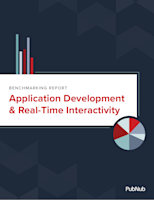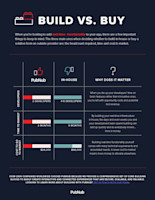Enhancing User Engagement Through AI-Driven Polls & Surveys

We recently released a study that found 36% of the 600 respondents plan to add artificial intelligence (AI) to their existing applications. In comparison, 25% intend to develop new AI-related apps in the next 8-12 months. (You can download your free copy here.)
Furthermore, in May 2023, Gartner released the results of a survey covering generative AI investments. Over 2,500 executive leaders reported that ChatGPT prompted them to increase AI investments — not a surprising result. What was unexpected, however, was that cost optimization wasn’t the primary reason, not by a long shot. Instead, leaders of organizations are leveraging AI to improve user experience.
We’ve recognized this shift in focus when making technology investments. AI offers a powerful, if not revolutionary, way to deliver unforgettable user experiences, particularly within apps. One of the most promising areas is delivering engaging AI-powered polls and surveys to determine what users want.
Let’s explore what we see on the horizon.
The digital transformation of polls and surveys: From analog to apps
Polls and surveys have been trusted to gather user opinions since before the internet, but not without major challenges. Online surveys made collection marginally easier, but app companies still experienced significant roadblocks in conducting and interpreting surveys:
Lack of personalization: Companies could disseminate surveys to groups of app users, but micro-targeting and micro-segmentation weren’t practical from a cost or execution standpoint.
Low engagement rates: A compelling 2021 micro-survey (before the mainstream adoption of business AI tools) noted that most surveys lacked the empathy and customization that encouraged users to complete them. The result? Low engagement and skewed or even misleading results.
Reliance on manual processes: Creating and executing app surveys traditionally requires heavy intervention from human teams, even when some measure of automation is involved. Automation options tend not to be “enough” regarding personalization, targeting, and timeliness.
The proliferation of apps should have made gathering feedback from polls and surveys easier, but companies encountered the same roadblocks as paper, phone, or email. Users have to want to fill them out, and many app surveys miss the mark regarding engagement.
There's good news, however. With the proliferation of AI-powered tools, app companies can move away from traditional survey strategies. Large language models (LLMs) like those in ChatGPT enable companies to shift towards an agile, hyper-responsive, and hyper-personalized survey approach that doesn’t overload human teams or blow IT budgets. This is the era of AI-driven, in-app feedback.
Talk to an Expert
Let's connect to discuss your real-time project.
Why AI-powered app surveys are the future of user engagement
Today, generative AI opens up many opportunities for improving polls and surveys from the most convenient platform for the user — the app. This takes a two-fold approach. The first improvement is in the delivery itself. With AI, companies can leverage:
Hyper-personalization: Generative AI generates content, meaning it can dynamically craft surveys for each user based on their specific behavioral data, activity on the app, and previous app survey responses.
Real-time question generation: Traditional survey creation can take weeks, while delivery and insights can stretch into months. AI can craft questions in real time as the user interacts with the app, helping target questions and facilitating response rates. App surveys become more interactive and interesting.
Multimodal surveys: Long lists of questions can send responders away before they ever finish the survey. Companies can use AI instead to deliver surveys through interactive elements, images, videos, storytelling, and gamification. This reduces the mental load required for app users to complete a survey while interacting with other app elements.
Multilingual capability: With more companies operating across borders and with diverse user bases, delivering multilingual surveys to target a user’s most comfortable language is a game changer. AI can generate these surveys in-app without companies needing expensive translation support each time.
Once users answer the app poll or survey, AI can also support teams to parse those results, enabling:
Actionable insights: Rather than returning with a wall of raw data, AI can uncover patterns and analyze information in real time, delivering actionable insights and next steps for data-driven decision-making.
Continuous improvement: AI can also learn from each app survey iteration, helping craft more effective polls and surveys in the future, increasing app engagement over time.
Predictive analytics and survey modeling: AI can also simulate survey results based on historical user data. Businesses can experiment “virtually” with different decisions, business changes, new features, and even specific app survey questions. This allows companies to take a proactive stance in user engagement.
AI can intelligently enhance in-app surveys and polls, creating a comprehensive user engagement strategy rather than the dreaded “crickets” of traditional survey methodologies.
Transforming app experiences with AI-powered surveys and polls
Where can app companies apply AI-powered surveys? Several compelling use cases emerge when it comes to user engagement.
Feature prioritization: Every app is a bundle of features, but discerning which ones deliver the most value is tricky. AI can wade through the noise to help developers determine where to spend their resources and what to phase out. It can also help predict the next big feature before users even ask.
User interface (UI) design: AI can gather feedback for elements in the user interface to help improve the design and create intuitive user experiences.
Bug prioritization: AI can help developers prioritize troubleshooting and ensure they address the most critical issues in their apps first. It can also help developers detect bottlenecks in any app or experience.
Usability testing: Dynamic surveys can evaluate how users navigate apps, determine the most valuable features, and uncover trouble spots.
User preferences: AI-powered surveys embedded in the app can help companies determine what content users wish to see and can gauge user reactions to content types. It can even simulate how users are likely to respond to changes. This also includes onboarding processes. AI-driven surveys can customize a user’s onboarding journey based on personalized questions and analysis.
Subscription models and pricing: Monetizing an app is a continual balance. With AI-driven surveys, businesses can understand what features users will pay for, how much, and what pricing model (subscription vs. one-time purchases) users prefer.
The future of polls and surveys lies in artificial intelligence
AI allows companies to reinvent their user interactions through in-app surveys and polls. Thoughtful implementation could improve engagement, deliver more profound insights into user preferences, and help companies craft dynamic and unforgettable user experiences with each app iteration. Leveraging AI to cut through the noise and process results transforms surveys from a laborious task to a fundamental piece in the user engagement puzzle — one that has the power to deliver real-time insights and ensure more willing participation.
The PubNub platform offers in-app social interactions that redefine the user survey. You can onboard as many users as necessary, create smooth live events, and create engaging experiences through real-time polls, surveys, and voting. PubNub allows you to confidently integrate cutting-edge generative AI tools — including apps and surveys — into your app.
Contact us to see it in action or schedule a free trial to experience how AI can reshape your user engagement.


